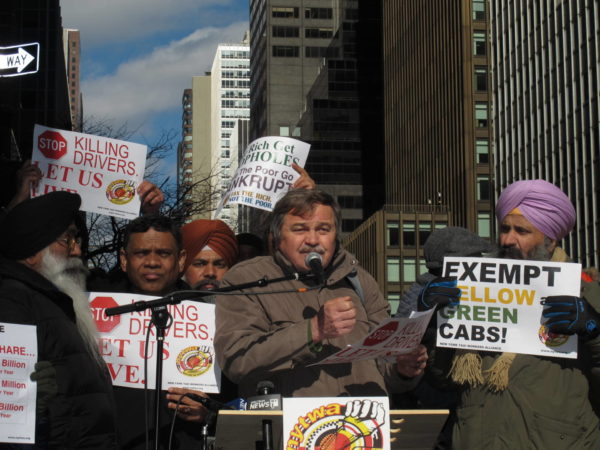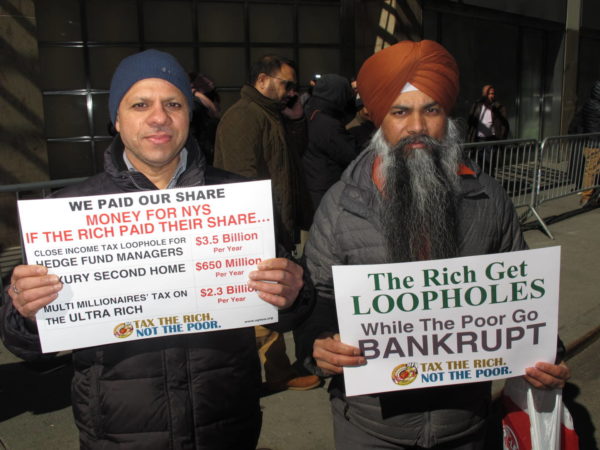NEW YORK, N.Y.—“No more suicide, no more bankruptcy,” taxi drivers chanted across the street from Gov. Andrew Cuomo’s Manhattan offices Feb. 26. Mohammed Mahbub, the driver leading the call-and-response chant, stretched the syllables out into a mournful wail, like a muezzin at a funeral.

The more than 150 drivers were calling on the governor to exempt yellow cabs from the state’s $2.50 congestion-pricing surcharge. That surcharge, levied on all fares below 96th Street in Manhattan, went into effect Feb. 2, after a State Supreme Court judge lifted a temporary restraining order won by owner-drivers suing to stop it. Drivers say it’s already cutting into their incomes.
“The $2.50 is a lot of money. Lose my customers,” says Lakwander Singh, 45, of Queens. Some people won’t tip him because of the surcharge, he adds, and some just refuse to pay it.
The surcharge particularly discourages short fares, such as elderly people taking a cab for 15 blocks, says Mohammad Hossein, 42, an owner-driver from Queens. “All big fares take the Uber,” he explains. “We get the small fares.”
Aboulaye Mbow, 57, of Harlem, shows his receipt from working almost 17 hours the day before, from 6:05 a.m. to just before 11 p.m. He grossed $320 on the meter from 22 fares, and got $50 in tips. But out of that, he had to pay $20 for the previous mass-transit and disability-access surcharges, $55 for the congestion-pricing surcharge, and $100 for the lease. That left him with about $11.50 an hour—before paying for gas.
Drivers have dubbed congestion pricing the “suicide surcharge,” one more blow to an industry where eight financially stressed drivers have killed themselves in the last year and a half. Yellow-cab drivers’ incomes have declined by 40% since 2015, Bhairavi Desai of the New York Taxi Workers’ Alliance told the crowd. NYTWA projects that the surcharge “could lead to as much as a 30% further drop,” as ridership in Manhattan’s central business district, where more than 90% of fares begin or end, “is expected to plummet.” City Taxi and Limousine Commission records show 80 medallions were foreclosed in January—more than in all of 2018, Desai said.
“What do you want from me [Governor Cuomo]? Do you want our blood, our organs? You should have some compassion for working people. — driver Nicolae Hent
“What do you want from me? Do you want our blood, our organs?” driver Nicolae Hent, facing the governor’s office, demanded. “You should have some compassion for working people.”
The state could cover the Metropolitan Transportation Authority’s fiscal needs without doing it on the backs of the working poor, Desai told the crowd. “There are small taxes on the wealthy that could easily cover the MTA,” she said.
It the state taxed hedge-fund managers’ fees and shares of profits as income instead of at the lower capital-gains rate, NYTWA contends, that could bring in $3.5 billion a year. A tax on second homes worth more than $5 million could raise $650 million, and raising taxes on income over $1 million would net another $2.3 billion, it adds.
New York State, Desai added, also automatically refunds all revenue it collects through its stock-transfer tax, 5 cents on every $20 worth of shares—a total estimated at $16 billion. Meanwhile, she noted, it now taxes a $10 cab ride at 30%.
The governor’s press office did not respond to questions from LaborPress. Earlier in the morning, Cuomo and Mayor Bill de Blasio announced a plan to charge a not-yet-determined congestion-pricing fee on almost all vehicles entering Manhattan south of 61st Street, with the money earmarked for the MTA. The fee would go into effect by the end of 2020.

The mayor conceded that Cuomo’s opposition to taxing the rich had left no alternative. “I still believe a millionaires’ tax provides the best, most sustainable revenue source for the transit improvements our city needs,” he said in a separate statement. “But the time to act is running out, and among all alternatives, congestion pricing has the greatest prospects for immediate success.”
The state projects that the congestion-pricing fee on yellow-cab rides will bring in $200 million a year, but “it’s not designed to be a revenue stream,” a NYTWA spokesperson told LaborPress. According to state budget figures, the 50-cent MTA surcharge on yellow and green taxis brought in more than $80 million a year from 2011 to 2015—but with ridership declining, receipts fell to $56 million in the 2018 fiscal year, and are projected to go down to $50 million in 2019.
If the $2.50 fee pushes out more drivers, that will reduce revenues even further, the NYTWA spokesperson says. It’s also unfair to charge yellow-cab drivers for congestion, he argues, because “by design” they’re supposed to be in the Manhattan business district.
Owner-drivers who owe money on their medallions can’t afford to quit. “Twelve hours is nothing,” says Jana Stroe, who’s been driving since the 1980s and owes $500,000 on the medallion she shared with her late husband. She drives for 16 hours a day, six days a week, and clears about $100 a day after expenses. She pays almost $100 a day in surcharges, she says.
“If I make $200, the surcharge is $60,” says Mohammed Mahbub, an owner-driver with “a $700,000 loan on my back,” who works seven days a week.
Taxing taxi drivers instead of the rich is “patently unfair,” says NYTWA cofounder Biju Mathew. “The governor has a choice. He can either be Amazon Cuomo or FDR Cuomo.”



